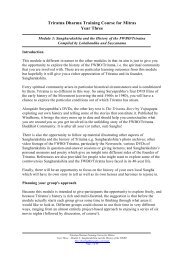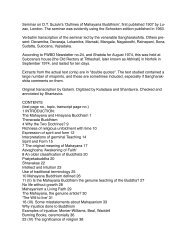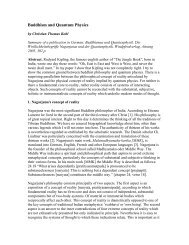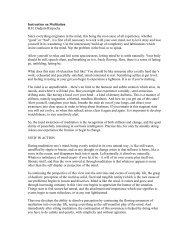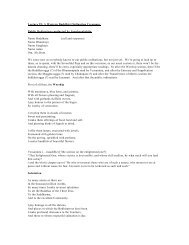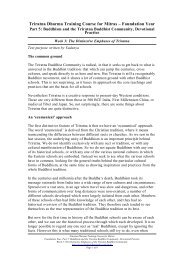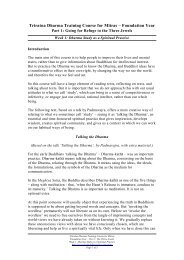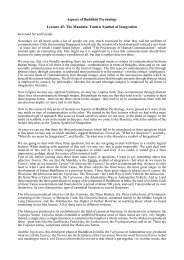Metta Bhavana - Introduction and Basic Tools - Free Buddhist Audio
Metta Bhavana - Introduction and Basic Tools - Free Buddhist Audio
Metta Bhavana - Introduction and Basic Tools - Free Buddhist Audio
You also want an ePaper? Increase the reach of your titles
YUMPU automatically turns print PDFs into web optimized ePapers that Google loves.
<strong>Metta</strong> <strong>Bhavana</strong> - <strong>Introduction</strong> <strong>and</strong> <strong>Basic</strong> <strong>Tools</strong>by Kamalashila<strong>Audio</strong> available at: http://www.freebuddhistaudio.com/audio/details?num=M11aGeneral Advice on MeditationOn this tape I’m going to introduce you to the second meditation practice, <strong>and</strong> this iscalled the “<strong>Metta</strong> <strong>Bhavana</strong>,” which means, “The Development of Friendliness.”I’ve just got one or two general pieces of advice, before we start.First of all, if you’ve decided to give meditation a try, why not do it properly? Whynot give your practice the best conditions for success? I expect it’s obvious that youneed as much peace <strong>and</strong> quiet as you can get to meditate undisturbed. But it wouldalso help very much if you practice at least once every day. And, if possible, thatshould be at the same time every day. It doesn’t matter when exactly you do it. It’sjust that if you’re regular, progress in meditation will come much more easily.To see if meditation is right for you, I suggest giving yourself a month to experimentwith it. After that, you can review any progress that you’ve made. And then, if youdecide that you’d like to take up meditation seriously, you’ll need some personalguidance. This tape can’t tell you everything you need to know. So then is the time tofind out about <strong>Buddhist</strong> meditation classes in your area. It isn’t just that you need tolearn more from an experienced teacher. It’s also important that you find support <strong>and</strong>encouragement by getting to know other people who meditate.The other general piece of advice is to learn to become more aware, both inmeditation <strong>and</strong> outside it. When you’re meditating, of course, be aware of what you’retrying to do. Keep reminding yourself that you’re focusing on the breathing ordeveloping friendliness, but also be aware of what is happening inside you. Noticeyour feelings. Notice your emotions. Notice your thoughts. And notice your body. Beaware of how you are holding yourself, how you are moving <strong>and</strong> what you areactually doing physically. If you can be aware in all these ways outside meditationtoo, you’ll find that you’re much better prepared for when you sit <strong>and</strong> meditate.Introducing the <strong>Metta</strong> <strong>Bhavana</strong>So, now I’ll introduce the second meditation.As I said, it’s called the <strong>Metta</strong> <strong>Bhavana</strong>. “<strong>Metta</strong>” means “friendliness” or “lovingkindness,”<strong>and</strong> “<strong>Bhavana</strong>” means something like “developing” or “creating.” So thisis the meditation that develops qualities like friendliness <strong>and</strong> kindness towards others.And, if you think about it, these are very, very important human qualities. TheBuddha was an extremely wise man, to say the least. But as well as being a wise man,he wasn’t irritable <strong>and</strong> grumpy, as sometimes very clever or intelligent people can be.In fact, he was known to have been very generous, warm <strong>and</strong> friendly. When hetaught, he would always adapt his instruction to the temperament <strong>and</strong> spiritual needsof the person he was speaking to. And, in Buddhism, this quality of friendliness isconsidered at least as important as concentration for our spiritual development. In1
fact, for many of us it may be even more important. I’m sure you know fromexperience that if you’re in a grumpy, irritable mood, your underst<strong>and</strong>ing is narrow<strong>and</strong> limited, but when you’re in a good state of mind, it’s easy to listen. It’s easy toconsider things objectively. It’s easy to underst<strong>and</strong>. And it’s also easier to actuallyfeel kind <strong>and</strong> friendly. Meditating on loving-kindness is a way you can activelycultivate healthier emotional states of mind.Something that’s very interesting about this meditation is the way it starts. Right inthe beginning, right at the very first stage, we’re asked to develop loving-kindnesstowards ourselves. It’s as though the practice is telling us that, if we want to befriendothers, we must first learn to befriend ourselves.The Structure of the Meditation <strong>and</strong> the First Stage: <strong>Metta</strong> for OneselfAt this point, I’m going to give quite a detailed description of each stage of themeditation, so don’t expect to take it all in at once. The <strong>Metta</strong> <strong>Bhavana</strong> is morecomplex than the Mindfulness of Breathing. So I’m giving you all this information torefer to later. When I’ve given this detailed description, I’ll lead you through thepractice itself. What you’re doing throughout this meditation is developing metta, orloving-kindness, <strong>and</strong> you do that in five stages. You first develop metta towardsyourself. Then you develop it, in turn, towards a good friend, someone who isemotionally neutral to you, <strong>and</strong> towards someone you find difficult. Then you imagineall these people together, developing metta towards them equally. And finally, youradiate the metta outwards to include everyone in the whole world.Now, to do all that, you need to be well prepared. So, when you sit down, you spend alittle time settling down, collecting your thoughts <strong>and</strong> getting in contact with whateveryou happen to feel at the moment. And in Stage One this is very important, at thisstage when you’re concentrating on yourself. So be aware of any emotions you feel.Maybe you feel joyful. Maybe you feel rather sad. Or maybe you couldn’t describewhat you feel in words. And that doesn’t matter. In fact, don’t even try. Justexperience whatever’s there. You may not feel anything at all, just a blank. Again, itdoesn’t really matter. Just feel blank - that’s how you feel. While you’re experiencingwhatever it is that you feel, generate friendliness <strong>and</strong> kindness toward yourself, <strong>and</strong>keep your attention as constantly as you can on that feeling.General Points on Developing <strong>Metta</strong>Now, before we go on to Stage Two, there are a few points that might be helpful inactually developing kindness <strong>and</strong> friendliness.When the experience you have at first is pleasant <strong>and</strong> enjoyable, you’re going to findit easy to feel kind <strong>and</strong> friendly. But when it’s painful or just blank, there’s probablymore of a tendency to react negatively. But remind yourself that these reactions arereally just habits. They’re habits that you can change. So watch out for thesereactions. Be patient, <strong>and</strong> whatever the circumstances, keep developing the metta asbest you can.And the metta might be rather weak at first. And that doesn’t matter. Don’t be put off,because it’s more difficult when you’re starting from cold. <strong>Metta</strong> <strong>Bhavana</strong> is like2
trying to get a flame from a smouldering ember. You need to use your imagination tocoax some new positive feeling into existence. It might help if you say to yourself,“May I be happy <strong>and</strong> well,” or something like that – any phrase that calls up a positiveemotion quite genuinely. And don’t just repeat any words that you might choose.Don’t just repeat them automatically. Consider their meaning, <strong>and</strong> allow yourself timeto actually respond to what you say.And yet another approach is to recollect a time when you were very happy, recapturein your imagination what that was like. Or you can consider all the potential whichyou have as a human being. You can reflect that you could actually realize thispotential with the right kind of effort. So, if you find this inspiring, reflect in that way.And what if you don’t find it inspiring? Well, you can just try something else.Experiment. Experiment in whatever way you like. Maybe it would help to reflect ona mental image. What about a flower? Say, a beautiful pink rose opening its petals?Or you could imagine a bright summer’s day. So, do you get the idea? I’m sayingthat you can explore <strong>and</strong> use any method you find helpful. These are just a few ideasthat I found helpful in getting some positive emotion flowing.And, as you gradually contact the quality of metta, concentrate on that quality withyour whole heart <strong>and</strong> your whole mind. The more you concentrate on any thought orfeeling, the stronger it gets. So, once you’ve contacted any degree of metta, focusupon it. Put your energy behind it, <strong>and</strong> over time it’ll get stronger.The Second Stage: <strong>Metta</strong> Towards a FriendSo, now we reach the second stage. We shift our focus of attention <strong>and</strong> develop mettatowards a friend. The actual person you choose for this stage can affect the quality ofthe practice. So, as a general rule, don’t choose someone for whom you might have,as it were, parental feelings. By that, I mean they shouldn’t be too much older or toomuch younger than you are. And it’s also a lot more straightforward if you don’tchoose someone for whom you might have sexual feelings. Now, this is actually agood friend of yours. So, developing the metta ought to be easy. In imagining them,you might have a visual image of their face. Or it might simply be a feeling aboutthem, or a general impression of them, that you concentrate on. It could even be amemory of a happy meeting in the past.Now, as you concentrate on them, experience the way that you’re responding to thememotionally. And, when you do this, be honest, because you may not always feel theway that you’re supposed to feel towards a friend. If you can acknowledge yourfeelings quite frankly, then this meditation can help you transform your habits. So, onthe basis of what you honestly feel, you respond to your friend very warmly. Yougenerate the strongest feelings of friendliness that you can. It doesn’t matter how youdo that. Just try to do it as strongly <strong>and</strong> as consistently <strong>and</strong> as steadily as you can. Andevery time you notice your mind has lost that focus, just bring it back again <strong>and</strong> again.And, in developing metta towards your friend, you can use the same methods as in thefirst stage. As before, you can say, “May he be happy. May he be well,” or use anyother method that you find is effective.The Third Stage: A Neutral Person3
Then comes the third stage – a neutral person. Somebody for whom you have noparticular feelings. You don’t like them. You don’t dislike them. They could besomebody you hardly know. Or you might know them very well indeed, but for somereason you just aren’t interested in them. Or perhaps they’re someone you often see,but never speak to. For example, what about the postman?As with the other stages, you bring them to mind <strong>and</strong> notice how that feels. Itprobably won’t be a very distinct feeling, or a very strong one. But stay with what’sthere, anyway, <strong>and</strong> look for a more friendly, or more interested, response to them.Of course, the most likely difficulty with a neutral person is that you just don’t feelanything. But there is a way to find more feeling, <strong>and</strong> that is to concentrate on them. Ifyou persist in concentrating, come back again <strong>and</strong> again to your impression of them,you will eventually start feeling something. You’ll get subtler feelings of pleasure orpain, <strong>and</strong> then you will feel more able to respond to them.The Fourth Stage: <strong>Metta</strong> towards a Difficult PersonSo that’s the neutral person.In the fourth stage we develop metta towards a difficult person – someone you’re notgetting on with – <strong>and</strong> choose anyone you rather dislike, or who you feel rather dislikesyou, or with whom there is some misunderst<strong>and</strong>ing or habitual non-communication.Once again, when you think of them, experience your actual response to them. Don’tlet your assumptions, about how you think they will make you feel, get in the way.Try to let go any feelings of animosity, <strong>and</strong> then cultivate a fresh response. Beunderst<strong>and</strong>ing. Be kind, even be compassionate. You find this person difficult to getalong with at present, but don’t forget that things can change, <strong>and</strong> don’t resist thepossibility that things might change. So, empathize with them. Put yourself in theirplace, remembering that the way they see their life is certain to be different from theway you perceive it. So, remembering the background <strong>and</strong> the conditions of their life,it’s easier to wish them happiness <strong>and</strong> well-being.Doing this doesn’t mean you have to compromise yourself with anything they mighthave done which you feel is objectively wrong. But here you can clarify your ownsubjective feelings of negativity towards them. You can try at least to drop your sideof any problem.If it seems appropriate, you can choose an out-<strong>and</strong>-out enemy – someone you reallyhate. But at first it’s wise not to make things too difficult for yourself. If your negativefeelings towards this person are very strong, you could end up completely distracted,even making the relationship worse. So, remember that the whole point of theexercise is to generate loving-kindness.The Fifth Stage: Equalizing <strong>Metta</strong> for All Four PeopleThe fifth stage of the <strong>Metta</strong> <strong>Bhavana</strong> starts by our concentrating on all the four peoplewe’ve mentioned so far <strong>and</strong> developing metta equally towards each of them.4
If you like, imagine them all sitting around you <strong>and</strong> then work to equalize your feelingof empathy <strong>and</strong> friendship. Make it equally strong for both your good friend <strong>and</strong> yourneutral person, towards both yourself <strong>and</strong> your difficult person, towards both yourdifficult person <strong>and</strong> your friend. And this stage can really stretch your imagination,<strong>and</strong> it really needs quite a lot of practice. So I suggest trying a simpler approach atfirst, which doesn’t involve quite so much analysis <strong>and</strong> comparison. So start by justimagining your metta flowing equally towards each person.Then comes the final part of the meditation. We allow the feeling of metta to flow outbeyond ourself <strong>and</strong> beyond our companions. We send it out to the whole universe. Sobegin by developing loving-kindness towards yourself <strong>and</strong> anyone else in the roomthat you’re in. Then start exp<strong>and</strong>ing the friendliness in ever-increasing circles toinclude everyone in the house, then in the area round about, in the whole town, thewhole country, the whole continent <strong>and</strong> the whole world. You’re making a sincerewish for everyone in the world, without exception, to be happy <strong>and</strong> free fromsuffering. So, whatever beings there are - whether human, or animal or whatever - youtry to imagine their lives <strong>and</strong> wish them happiness. And you exp<strong>and</strong> this feeling asuniversally as you can possibly conceive. You don’t have to stop even with our ownworld. According to the <strong>Buddhist</strong> tradition, at least, there are likely to be other lifeforms in the universe too, so wish them all well. View them all with kindness <strong>and</strong>encouragement. We are using our imagination to exp<strong>and</strong> our empathy with humanitybeyond all conceivable limits – beyond even what we can imagine.5



